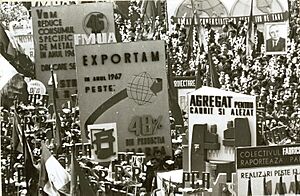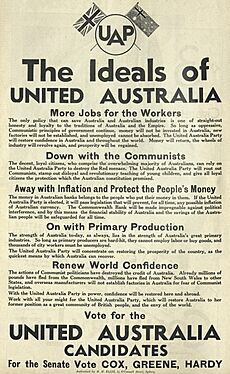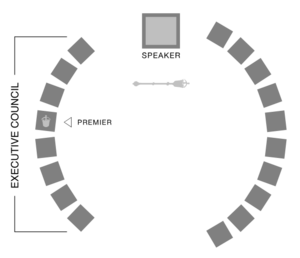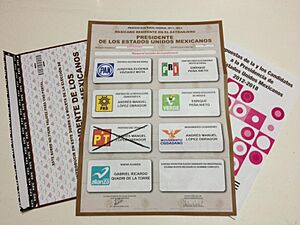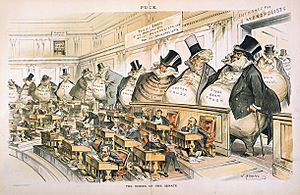Political party facts for kids

A political party is a group of people who work together to get their chosen candidates elected in a country or area. Members of a party usually share similar ideas about politics. They often aim to achieve specific goals or plans.
Political parties are a big part of how almost every country is run today. Modern party groups have grown and spread worldwide over the last few centuries. While some countries do not have political parties, this is very rare. Most countries have many parties, but some only have one. Parties are important in both autocracies (countries ruled by one person or a small group) and democracies. Democracies usually have more political parties than autocracies. Autocracies often have one main party that governs the country. Some experts believe that having two or more parties compete is a key part of democracy.
Parties can form from existing differences in society, like between different social classes. They help make political decisions easier by encouraging members to work together. A political party usually has a leader who guides its activities. It also has executives who handle tasks and members who volunteer, donate money, and vote. There are many ways parties are set up and how they connect with voters. Laws often control how citizens can donate to parties. Sometimes, parties may make decisions that favor those who donate time and money.
Many political parties are driven by their beliefs. In democratic elections, you often see liberal, conservative, and socialist parties. Other common beliefs for large political parties include communism, populism, nationalism, and Islamism. Parties in different countries often use similar colors and symbols to show their beliefs. However, some parties do not have a strong ideology. They might focus on helping specific people, supporting a political entrepreneur, or being a "big tent" to attract many voters with different views.
Contents
What is a Political Party?
Political parties are groups that organize to compete for political jobs. Their members run in elections under a shared name. Simply put, a political party can be just the group of candidates running under one party's name. More broadly, a political party includes everyone who helps elect those candidates. This includes voters and volunteers who support the party, the official groups that help with elections, and lawmakers in the government who belong to that party. In many countries, laws define what a political party is. Governments may set rules for a group to be officially recognized as a party.
Political parties are different from other groups like parliamentary groups or advocacy groups. A party focuses on electing candidates. A parliamentary group is a collection of political parties. A political faction is a smaller group within a party. An advocacy group works to promote a specific policy. Parties usually have more members, last longer, and have a stronger connection to voters.
How Political Parties Started
The idea of people forming groups to push for their shared interests is very old. Ancient thinkers like Plato and Aristotle wrote about political groups in old Greece. There were also groups in the late Roman Republic and the Dutch Republic. However, modern political parties began around the late 1700s. They first appeared in Europe and the United States. The Conservative Party in the United Kingdom and the Democratic Party in the United States are often called the world's "oldest continuous political parties."
Before modern parties, elections were less competitive. Small areas sometimes used direct democracy, where people made decisions directly. Elections were often controlled by small groups or individuals who could help a candidate win.
Parties in the 1700s
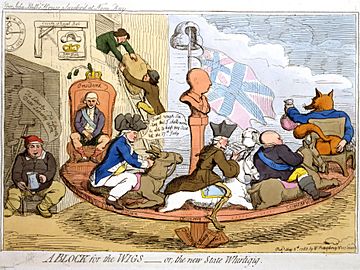
Some experts believe the first modern parties started in Britain in the 1600s. This was after big events like the Exclusion Crisis and the Glorious Revolution. The Whig group supported a Protestant constitutional monarchy (a king or queen with limited power). The Tory group (who were once called Royalists) supported a strong monarchy. These two groups shaped British politics throughout the 1700s. The Rockingham Whigs are seen as the first modern party because they kept their name and beliefs even when they were not in power.
By the end of the 1700s, the United States also developed a party system. This was called the First Party System. The people who wrote the 1787 United States Constitution did not expect parties to form. But arguments in the early 1790s about the power of the federal government led to two early parties: the Federalist Party and the Democratic-Republican Party.
Parties in the 1800s
By the early 1800s, many countries had stable modern party systems. Sweden's party system is sometimes called the world's first truly stable one. In many European countries, like Belgium, Switzerland, Germany, and France, parties formed around liberal and conservative ideas, or around religious differences. The 1848 Revolutions across Europe helped parties spread even faster.
The strength of parties in the United States weakened for a while, but grew strong again by the late 1800s. Other countries also saw parties become much stronger. For example, the Irish leader Charles Stewart Parnell introduced methods like party discipline that made parties more organized and powerful at the local level.
Parties in the 1900s
In the early 1900s, socialist parties emerged in Europe. They attracted support from organized trade unions. This changed the usual liberal-conservative party systems.
During the time of decolonization in the mid-1900s, many newly independent countries outside Europe and North America developed party systems. These often grew from their independence movements. For example, parties in India grew from groups in the Indian independence movement. They became stronger in the 1970s. The Indian National Congress formed in the late 1800s as a pro-independence group. It became a major party after India gained independence. This was similar to what happened in many new countries. For instance, the Uganda National Congress was Uganda's first party, formed to gain independence. Its name honored the Indian National Congress.
As more people gained the right to vote, and eventually universal suffrage (everyone being able to vote), political parties grew a lot. Only then did people start to see parties as a link between the public and the government.
Why Do Political Parties Exist?
Political parties are found in almost every modern country. Nearly all democratic countries have strong parties. Many experts believe that countries with fewer than two parties are usually autocratic. However, a country with many competing parties is not always democratic. Many autocratic countries also have one main political party. Because parties are so common and strong, researchers wonder why they are such a key part of modern states. Political scientists have several ideas about why parties are found almost everywhere.
Social Differences
One main idea is that parties come from existing differences among people. Society is divided in some way, and a party forms to organize those differences into elections. By the 1950s, experts showed that parties could use voters' preferences on issues. They would adjust their ideas to become more competitive. In the 1960s, researchers began finding social differences in countries that might have led to specific parties. For example, religious differences might have created religious parties.
This idea has faced some criticism. Some say there is no proof that parties come from existing differences. Others argue that parties can also cause changes in social differences. Another point is that if parties come from social differences, then the theory is incomplete unless it also explains where those social differences come from.
Helping Candidates and Lawmakers
Another reason parties are everywhere is that they help candidates and lawmakers work together. Parties can help candidates in different areas coordinate. A candidate in one area might help a similar candidate in another. So, parties can stop candidates with similar goals from hurting each other when campaigning or governing. This might explain why parties are so common: if a group of candidates forms a party and works together, they might do better than politicians without parties.
Parties can also help their members agree when they are in a legislature (a law-making body). A party structure can help groups of voters agree on the best policy choices. Without parties, lawmakers might never agree on a single best policy.
Parties as Shortcuts for Voters
Another important reason for parties is psychological. Parties can make it much easier for many people to take part in politics. They offer a huge shortcut. This allows people to make informed choices with much less mental effort. Without parties, voters would have to research every candidate in every election. Parties let voters judge just a few groups. Then, they can apply their judgment of the party to all its candidates. It is much easier to learn about a few parties' plans than about many independent candidates. So, parties make it simpler for people to vote wisely. However, some evidence suggests that over the last few decades, people's strong connection to parties has been weakening. So, this might be less important now than in the past.
How Political Parties are Organized
Political parties often have similar structures in different countries. They usually have a single party leader, a group of party executives, and many party members. Parties in democracies usually choose their leaders in more open and competitive ways. In autocracies, choosing a new leader is often tightly controlled. In countries with large regions, especially federal countries, there might be regional party leaders and members in addition to national ones.
Party Leaders
Parties are usually led by a party leader. This person is the main face of the party. They are often in charge of the party's policies and plans. The leader of the party that controls the government usually becomes the head of government, like the president or prime minister. Leaders of other parties openly compete to become the head of government. In both presidential and parliamentary democracies, party members often have a big say in choosing leaders. For example, they might vote at a party conference. Because a major party leader is powerful and well-known, many are experienced politicians. Party leaders can be so famous that they affect how voters see the whole party. Some voters decide how to vote based on how much they like the leaders.
The number of people involved in choosing party leaders varies a lot. On one side, leaders might be chosen by all voters. On the other side, they might be chosen by just one person. A smaller group often chooses leaders in more autocratic countries. There, political parties might be limited to only one legal party, or only one competitive party. Some of these parties, like the Chinese Communist Party, have strict ways of choosing the next leader. This involves selection by other party members. A few single-party states have leaders who inherit their position from a parent. Autocratic parties use strict selection methods to avoid big changes in the government when a new leader takes over.
Party Executives
In both democratic and non-democratic countries, the party leader is often part of a larger leadership group. A party executive usually includes administrative roles, like a party secretary and a party chair. These might be different people from the party leader. These executive groups can limit the power of the party leader, especially if that leader is an autocrat. Parties often make big leadership decisions, like choosing executives and setting policy goals, during regular party conferences.
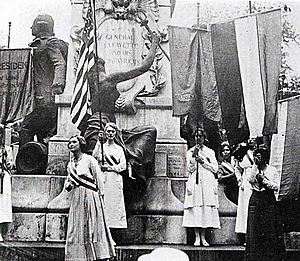
Just as party leaders not in power compete to become head of government, the whole party executive may compete for different government positions. For example, in Westminster systems, the largest party not in power forms the Official Opposition in parliament. They choose a shadow cabinet. This group shows which party members would hold which government jobs if their party won an election.
Party Membership
Citizens in a democracy often join a specific political party. Being a party member might mean paying fees. It might also mean agreeing not to join multiple parties at once. Sometimes, it means agreeing with the party's policies. In democracies, party members can often vote to choose the party leadership. Party members often form the group of volunteers and donors who support parties during campaigns. How much people participate in party groups can depend on a country's political rules. Certain electoral systems and party systems encourage more party membership. Since at least the 1980s, membership in large, traditional party groups has been slowly decreasing in many countries, especially in older European democracies.
Types of Political Parties
Experts have identified different types of political parties that have changed over time. These include elite parties, mass parties, catch-all parties, and cartel parties. Elite parties were groups of political leaders who focused on elections and limited outside influence. Outsiders only helped with campaigns. Mass parties tried to get many new members. These members provided money and often spread the party's ideas and helped with elections. In the United States, where both major parties were elite parties, changes like primaries have made them so that activists have more power.
Experts also talk about strong parties, where decisions are made from the top down. And weak parties, where decisions are made more locally by members.
Elite Parties
An elite party was common in the 1800s, before everyone could vote. The French expert Maurice Duverger first described elite and "mass" parties based on how they were organized. Elite parties have very little organization. They get money from a few large donations, usually from outside the party. Elite parties do not focus on getting many members. Their leaders are often their only members. The earliest political parties, like the Democratic-Republicans and the Federalists, were elite parties.
Mass Parties
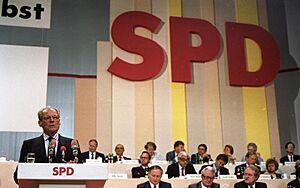
A mass party developed around differences in society. It brought together ordinary citizens or 'masses' into politics. In Europe, when everyone gained the right to vote, worker's parties were created. These later became mass parties. An example is the German Social Democratic Party. These parties represented large groups of citizens who had not been involved in politics before. They spoke for the interests of different groups in society. Unlike elite parties, mass parties get money from their members. They rely on and keep a large number of members. Also, mass parties focus on getting voters involved and are more centralized than elite parties.
Catch-all Parties
The term "catch-all party" was created by the German-American expert Otto Kirchheimer. He used it to describe parties that developed in the 1950s and 1960s. These parties changed from the traditional mass parties. The term "big tent party" means the same thing. Kirchheimer said that catch-all parties "drastically reduced their ideological baggage." They also "downgraded the role of the individual party member." By making their main ideas more open, catch-all parties try to get support from a wider range of people. Also, the role of members is less important because catch-all parties get money from the government or from donations. In Europe, Christian Democratic parties that were based on religion changed into broader centre-right parties. This is a good example of this type of party.
Cartel Parties
Cartel parties appeared after the 1970s. They get a lot of money from the government. Their beliefs are less important as a way to organize. The idea of cartel parties was developed by Richard Katz and Peter Mair. They wrote that parties have become "semi-state agencies." This means they act for the government rather than for groups in society. The word 'cartel' means that powerful parties in government make it hard for new parties to join. They form a group of established parties. Like catch-all parties, the role of members in cartel parties is not very important. Parties use government money to stay in power.
Niche Parties
Niche parties developed because of new differences and issues in politics, like immigration and the environment. Unlike mainstream or catch-all parties, niche parties focus on a limited set of interests. They do not fit the main economic left-right political divide. Instead, they highlight issues that other parties do not focus on. Also, niche parties do not change their views as much based on public opinion as mainstream parties do. Examples of niche parties include Green parties and extreme nationalist parties, like the National Rally in France. However, over time, these parties can grow and become less "niche" as they get bigger. This has happened with European Green parties, which changed from radical environmental groups to mainstream center-left parties.
Entrepreneurial Parties
An entrepreneurial party is a political party that is built around a political entrepreneur. It focuses on helping that person or their policies. Some definitions say a party is a group that promotes specific beliefs or policy goals. But many parties are not mainly driven by beliefs or policies. Instead, they exist to help a specific politician's career.
Party Beliefs and Ideas
Political beliefs are a main way political parties are organized. Parties often officially link themselves with specific beliefs. Parties adopt beliefs for several reasons. Having a political belief tells people what kinds of policies a party might try to achieve if it were in power. Beliefs also make parties different from each other. This helps voters choose the party that supports the policies they like most. A party might also try to spread its beliefs by convincing voters to adopt its ideas.
Common beliefs that are central to a political party's identity include liberalism, conservatism, socialism, communism, anarchism, fascism, feminism, environmentalism, nationalism, fundamentalism, Islamism, and multiculturalism. Liberalism is most connected to the history of democracies. It is often seen as the main or default belief of ruling parties in much of the world today. Many traditional rivals to liberal parties are conservative parties. Socialist, communist, feminist, anarchist, fascist, and nationalist parties are newer. They mostly entered politics in the 1800s and 1900s. Environmentalism, multiculturalism, and certain types of fundamentalism became important in the late 1900s.
Parties can sometimes be organized by their beliefs using an economic left–right political spectrum. However, a simple left-right economic line does not fully show all the different party beliefs. Other common ways to compare party beliefs include ranges from liberal to authoritarian, from pro-establishment to anti-establishment, and from tolerant to anti-system.
Party positions for individual parties are measured by different published tools, like the V-Party Dataset.
Parties Without Strong Beliefs
Even though beliefs are central to many parties, not all parties have a main belief or exist to promote specific ideas. For example, some parties might be clientelistic or patronage-based groups. These groups are mainly focused on giving out goods or favors. Other parties might be created to help an individual politician's career. It is also common, in countries with important social cleavages (differences) based on ethnic or racial groups, for parties to represent the interests of one group. This might be a non-ideological attachment to that group's interests, or it might be based on an ideology like identity politics. While any of these types of parties can be ideological, there are parties that do not have any main belief.
Party Systems
Political parties are found in both democratic and autocratic countries. The parties that have a chance of holding power in a country often do not change much from one election to the next. This means we can think of the political parties in a country as forming one of its main political institutions, called a party system. Some basic features of a party system are the number of parties and which parties are most successful. These features are closely linked to other big parts of a country's politics. This includes how democratic it is, what rules its laws place on parties, and what type of electoral system it uses. Even in countries where the number of parties is not officially limited by law, political rules affect how many parties can succeed. For example, democracies that use a single-member district electoral system (where only one person is elected per area) tend to have very few parties. Countries that use proportional representation (where parties get seats based on their vote percentage) tend to have more. The number of parties in a country can also be estimated based on the size of its electoral districts and the number of seats in its legislature.
One helpful way to classify party systems is by how many parties they include. Some systems have many parties that have a very low chance of winning elections. So, it is often useful to think about the effective number of parties (the number of parties weighted by their strength) rather than just the total number of registered parties.
Non-Party Systems
In a non-partisan system, no political parties exist, or they are not a major part of politics. There are very few countries without political parties.
In some non-partisan countries, forming parties is banned by law. Parties might be banned in autocratic countries to prevent changes in power. For example, in Saudi Arabia, banning parties helps protect the monarchy. However, parties are also banned in some places with long democratic histories. This usually happens in local or regional elections in countries that have strong national party systems.
Political parties may also temporarily disappear in newly formed countries. Or in countries that have had big political changes and have not yet returned to a stable party system. For example, the United States started as a non-partisan democracy. It developed a stable party system over many decades. A country's party system might also break down and take time to reform. This leaves a period with few or no parties, like in Peru after the rule of Alberto Fujimori. However, it is also possible (though rare) for countries with no party bans, and no major disruptions, to still have no political parties. There are a few Pacific island democracies, like Palau, where parties are allowed but are not an important part of national politics.
One-Party Systems
In a one-party system, one political party holds all the power. When only one party exists, it might be because other parties are banned. This is common in authoritarian states. For example, the Communist Party of Cuba is the only allowed party in Cuba. It is the only party that can hold seats in the legislature. When only one powerful party is legally allowed, its members can include a very large part of society. It can play big roles in civil society that are not directly about governing. The Chinese Communist Party is an example of this. Bans on competing parties can also make sure that only one party can realistically hold power, even without completely banning all other parties. For example, in North Korea, more than one party is officially allowed. They can even have members in the legislature. But laws make sure the Workers' Party of Korea stays in control.
It is also possible for countries with free elections to have only one party that holds power. These cases are sometimes called dominant-party systems. Experts have debated whether a country that has never had a transfer of power from one party to another can still be called a democracy. There have been times when one party ruled almost completely in some countries that are often seen as democratic. These countries had no official legal barriers to other parties joining the government. This includes recent times in Botswana, Japan, Mexico, Senegal, and South Africa. It can also happen that one party dominates a region within a democratic country that has a competitive national party system. An example is the southern United States for much of the 1800s and 1900s. There, the Democratic Party had almost complete control. The Southern states were basically one-party regions, even though opposition parties were never banned.
Two-Party Systems
In some countries, only two parties have a real chance of forming the government. One current example of a two-party system is the United States. For much of its history, the national government has been controlled by either the Democratic Party or the Republican Party. Other countries that have had long periods of two-party rule include Colombia, Uruguay, Malta, and Ghana. Two-party systems are not only in democracies. They can also be in authoritarian governments. Competition between two parties has happened in past autocratic governments in countries like Brazil and Venezuela.
A democracy's political rules can shape the number of parties it has. In the 1950s, Maurice Duverger noticed that elections where only one person is elected per area by getting the most votes tend to create two-party systems. This became known as Duverger's law. Whether this pattern is always true has been debated for decades. Some experts have expanded this idea. They argue that stricter political rules (like "first past the post" elections) tend to create fewer parties. So, very small party systems – like those with only two parties – often form in countries with very strict rules.
Two-party systems have been criticized for limiting voters' choices. Much of this criticism focuses on their link to strict political rules. For example, some say that political rules in major two-party systems, like the United States, were designed to stop any third party from becoming competitive. Criticisms also focus on these systems' tendency to encourage insincere voting (voting for a less preferred candidate to prevent a worse outcome) and the spoiler effect (where a third candidate takes votes from a similar main candidate, causing an unwanted winner).
Multi-Party Systems
Multi-party systems are systems where more than two parties have a real chance of holding power and influencing policies. Many systems around the world have had periods of multi-party competition. Two-party democracies might even be seen as unusual compared to multi-party systems. Many of the largest democracies in the world have had long periods of multi-party competition. These include India, Indonesia, Pakistan, and Brazil. Multi-party systems encourage different types of government than smaller party systems. For example, they often encourage the formation of coalition governments (where multiple parties join to form a government).
Having many competing parties is usually linked to a higher level of democracy. A country changing from a one-party system to a multi-party system is often seen as becoming more democratic. Authoritarian countries can have multi-party competition, but this usually happens when elections are not fair. For this reason, in two-party democracies like the United States, people who support new competitive parties often argue that having a multi-party system would make the country more democratic. However, whether multi-party systems are more democratic than two-party systems, or if they lead to better policies, is a big debate among experts and the public. On the other hand, a country with a very large number of parties can have ruling groups that include parties with very different beliefs. These groups might struggle to make much policy progress. This can make the country unstable and lead to many elections. Examples of systems that have been described as having these problems include recent times in Israel, Italy, and Finland. Multi-party systems are often seen as fairer or more representative than one- or two-party systems. But they also have downsides. For example, in a system with plurality voting (where the winner just needs the most votes, not a majority), the winner of a race with many options might only have minority support.
Some multi-party systems might have two parties that are clearly more competitive than the others. These are sometimes called "two-party-plus" systems. This refers to the two main parties, plus other parties that exist but rarely hold power. Such parties can still be very important in election results. It is also possible for very large multi-party systems, like India's, to be mostly made up of regional contests that realistically have only two competitive parties. But overall, this can lead to many more than two parties playing major roles in the country's national politics.
How Parties Get and Use Money
Many activities of political parties involve getting and spending money to reach political goals. The money involved can be huge. Modern elections in the largest democracies often cost billions of dollars. Much of this money is paid by candidates and political parties. They often create complex fundraising groups. Because paying for elections is such a key democratic activity, how political parties are funded is an important part of a country's politics.
Where Party Money Comes From
Common sources of party money in different countries include members who pay dues, advocacy groups, lobbying groups, companies, trade unions, and candidates who use their own money. In most countries, the government also provides some money for political parties. Nearly all of the 180 countries studied by the International Institute for Democracy and Electoral Idea have some public funding for parties. About a third have regular government payments that go beyond just paying back campaign costs. In some countries, public funding depends on the party's size. For example, a country might only give money to parties with a certain number of candidates or supporters. A common argument for public funding is that it creates fairer elections by allowing more groups to compete. Many who support private funding argue that donations are a form of political expression that should be protected in a democracy. Public funding for parties might reduce parties' need to find money through illegal ways.
One way to group party funding sources is public funding versus private funding. Another way is plutocratic (from wealthy people) versus grassroots (from many small donors). Parties that get a lot of money from large companies might follow different policies than parties mostly funded by small donations from individual supporters. Private funding can also come from inside or outside the party. Inside funding is from members' dues or candidates' contributions. Outside funding is from non-members, companies, or trade unions. Inside funding might be preferred because outside sources could make the party loyal to an outside group.
How Parties Use Money
Political parties can spend money in many ways to win elections. Parties often spend money to train activists, find volunteers, create advertisements, do research, support their leaders between elections, and promote their policy plans. Many parties and candidates use a practice called clientelism. This is when they give material rewards to people in exchange for political support. In many countries, this is illegal, but it can still be common. Some parties directly engage in vote buying, where they give money to a person for their vote.
While it might be important for a party to spend a certain amount to win an election, there are usually diminishing returns for spending more during a campaign. Once a party spends past a certain point, adding more money might not increase their chance of success.
Rules for Party Money
Governments usually regulate how political parties raise and spend money. Many countries' rules focus on who can donate money, how parties can spend it, and how much money can go through a party. Two main ways rules affect parties are by controlling their income sources and by requiring them to be open about their funding. One common rule on how parties get money is to limit who can donate. For example, people who are not citizens of a country might not be allowed to donate to that country's parties. This helps prevent foreign interference. It is also common to limit how much money an individual can give to a party in each election. Similarly, many governments cap the total amount of money each party can spend in an election. Transparency rules might require parties to share detailed financial information with the government. In many countries, these disclosures must be public. This helps prevent corruption. Creating and changing laws about party spending can be very hard. This is because governments might be controlled by the very parties these rules restrict.
Party Colors and Symbols
Nearly all political parties use specific colors and symbols. This helps voters identify, recognize, and remember the party. This branding is especially important in places where many people might be unable to read. So, someone who cannot read a party's name on a ballot can still identify it by its color or logo. Parties with similar beliefs often use the same colors in different countries. Color associations are useful as a quick way to talk about and show parties in pictures. They can also be used to refer to coalitions (groups) and alliances between parties and other groups. Examples include purple alliances, red–green alliances, traffic light coalitions, pan-green coalitions, and pan-blue coalitions.
However, links between color and belief can also be inconsistent. Parties with the same beliefs in different countries often use different colors. Sometimes, competing parties in a country might even use the same colors. These associations also have big exceptions. For example, in the United States, red is linked with the more conservative Republican Party. Blue is linked with the more left-leaning Democratic Party.
| Belief | Colors | Symbols | Examples | |
|---|---|---|---|---|
| Agrarianism |
|
|
  |
|
| Anarchism |
|
|
  |
|
| Centrism |
|
   |
||
| Christian Democracy |
|
Christian cross |  |
|
| Communism |
|
|
  |
|
| Conservatism |
|
  |
||
| Democratic socialism |
|
|
 |
|
| Fascism |
|
 |
||
| Feminism |
|
|
  |
|
| Green politics |
|
|
   |
|
| Islamism |
|
Star and crescent |  |
|
| Liberalism |
|
Bird in flight |  |
|
| Libertarianism |
|
|
 |
|
| Monarchism |
|
Crown |  |
|
| Pacifism |
|
|
   |
|
| Social democracy |
|
|
 |
|
| Socialism |
|
Red rose |  |
See also
 In Spanish: Partido político para niños
In Spanish: Partido político para niños
- Cordon sanitaire (politics)
- List of banned political parties
- List of largest political parties
- List of ruling political parties by country
- Lists of political parties
- Lists of political parties by country
- Testimonial party
- Uniparty


